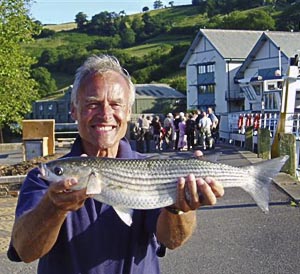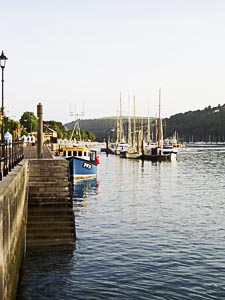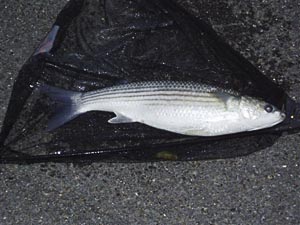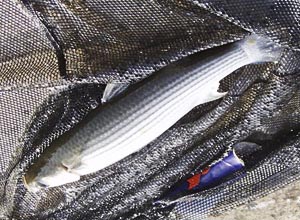|
|
||||||||
MIKE BAILEY - MULLET FISHING
ON THE EMBANKMENT IN DARTMOUTH TOWN |
||||||||
|
It’s been an exceptional year for Mullet, with the summer months consistently producing large numbers of fish. . Nothing spectacularly large, but a good sprinkling of fish between 4 to 5lb giving excellent sport from many of the upper river marks fishing the River Dart.
However, the seasons move on, and during September, catches suddenly took a nose dive. Little by little, the fish started to drift further downstream towards the middle and lower stretches of this huge river estuary. The River Dart presents many challenges as it broadens and deepens. There are vast expanses of tidal mudflats, heavily wooded sections right down to the shoreline, and private gardens which make access difficult or completely impossible for large stretches of the river for a shore angler. Dartmouth itself presents some fishing possibilities, but during the tourist season the areas that can be fished are limited due to the throngs of visitors. This has always put me off trying this area in the past, but there is something very satisfying about trying out somewhere new, and so I determined to give it a try, now that the main holiday season was over for another year. The area I had chosen was the Embankment which runs from the Lower Ferry to the Higher Chain Ferry, an area which I knew to contain numbers of fish. First I looked at the tide tables and picked a small neap that fell to low water at 10 am. The forecast for the day was encouraging, showing a gentle and warm westerly wind. The morning dawned fair and soon I was crossing the picturesque Dart between Kingswear and Dartmouth on the ferry. The water was glassy calm with a thousand reflections gently rippling in the green , clear waters. The air was fresh and warm and it was still early in the morning. The first thing I did was to take a walk along the side of the Embankment to look for features that would be attractive to the fish. This stretch is full of pontoons, jetties and moorings, all of which provide attractive areas for the fish to hide under, together with weed to feed from. The marina at the top end of the Embankment was very shallow already and some very good sized fish could be seen appearing and disappearing back from under the pontoons. However, although this looked promising, the tide still had some hours to fall, meaning it would soon have virtually no water close to the side; moreover, unless you had a boat moored at the pontoons it was almost impossible to fish there.
A look in the Boat Float which joins the Dart to a safe anchorage on the other side of the road, saw more Mullet, mainly small, swimming about in the tangle of mooring lines, and small boats. What I needed was a place that was immediately adjacent to this so I could intercept the fish as they waited to move in and out of this attractive fish holding area. By the side of the Boat Float were numbers of floating pontoons, and where these ended there was good depth of water. Moreover, nearby were some convenient steps, which would make it easy to land any hooked fish, ( otherwise a drop net would be essential, especially towards low tide.) The other side of the boat Float entrance also had similar structures and the water was even deeper here, but in the event I decided that the shallower water would be a good starting point, and got ready to set up. Although there were plenty of moorings and cables there were also good stretches of clear water, and so I decided to use 4lb line, as I felt confident I could turn and play fish away from these structures without a break. (If I had been fishing in an area of heavy snags I would have increased my line strength to 6lb or even higher if it meant I had to hold a big fish without letting it run.) Balls of bread ground bait, heavy in consistency, were thrown upstream into the chosen swim. The flow of the current was already weakening as shown by the way the particles of bread drifted down. As a result I was able to choose a very light "Chubber" float…I would not need to use much shot to keep the bait near to the bottom. Setting up the gear was done quickly. Below the float was a small line of shot, each smaller than the last, ending with a tiny dust shot about 6 inches from the number 8 hook. Plumbing the depth confirmed that the bottom was fairly level here with about 5-6 feet of water. A generous piece of soft paste was attached to the hook and I was ready. A small handful of mashed bread went into the swim and then I flicked my bait into the centre of it. Catastrophe!!! A swan appeared from nowhere and its head shot under the water towards my bait. A violent movement of the rod removed the bait just as this feathered jumbo got it into its beak. After leisurely eating the bait the swan sat there expectantly, its beady black eyes attentively watching my every movement.. It then stretched its long neck right down into the water in an exploratory probe, and had clearly seen the balls of ground bait not that far below in the crystal clear water. No amount of demented hissing and waving of the rod in its general direction had the remotest effect! The tide was dropping and soon the ground bait would be within reach. It was clear that it had no intention of moving any time soon, and I was unable to start fishing as any bread cast anywhere near would have instantly been gobbled up. Stalemate and a great deal of frustration. Deliverance came in an unlikely form. A little old lady arrived, with a large plastic bag, and took out several loaves of bread. She was some distance upstream, but when she started to throw scraps of the bread into the water, the avian dinner gong had been sounded. Clouds of screeching gulls mobbed each other for this bonanza and the swan was not about to miss out on an easy meal, and paddled silently and furiously into the distance. Problem solved! Now I could concentrate on the fishing and flicked the bait out close to the side. There is always that expectant moment when you fish somewhere new. Often you have a wait before things start to happen. My float settled and started to drift very slowly and gently along in the current, then dipped sharply. Before I could react it had returned to the surface. The bait was gone, but there was a fish there! For the next few minutes the same pattern was repeated. A small handful of ground bait, my bait dropped gently into the falling cloud, followed by fast and smooth bites. I kept missing them, but suddenly my strike was rewarded by the rod arching over; there in the clear water was the unmistakable golden gleam of a small Mullet, and it ran off against the clutch, giving a good account of itself on the light tackle. It was soon beaten, a fish of about one and a quarter pounds, and then I drew it to the steps some distance away, netted and released it. This was an encouraging start, but things were to get much better. After a quiet period of a few minutes, the bites started again. In no time at all, another fish was hooked. After a brief tussle, the hook came out, but within moments, another fish was hooked and quickly landed. For the next hour or so down to low tide, bites and fish followed at regular intervals. After a while I noticed that my float was lifting and I was missing too many bites. It was clear that the shoal of fish were hitting the baits “ on the drop”. A change in the depth so that I was fishing a few feet off the bottom, led to instant success, with the float shooting violently under. Most of the Mullet were smallish and none were bigger than just over 2lb, but they provided great sport on the light tackle.
As the tide stood and turned the bites started to tail off, and then died away completely. A few much larger fish, up to about 4lb, swam through the swim, but showed only a passing interest in the ground bait, and then were gone. By now clusters of holiday makers were starting to appear, and the boat traffic on the river was building up all the time. Time to go……………but not quite…. I decided to move further upstream to the edge of the Marina, where there was now a greater depth of water. For a while nothing happened, then a few bites heralded more Mullet. Eventually, I took another, not large, but a fish of about one and a half pounds. A nice way to finish after a session that saw nine fish taken.
A great morning’s fishing and it won’t be too long before I’m back to try again, hopefully picking out one of the larger fish that I spotted. The lower Dart can produce fish well into the autumn and even early winter in a mild year, so I’m hoping to have some more productive sessions there over the next few months. |
||||||||




